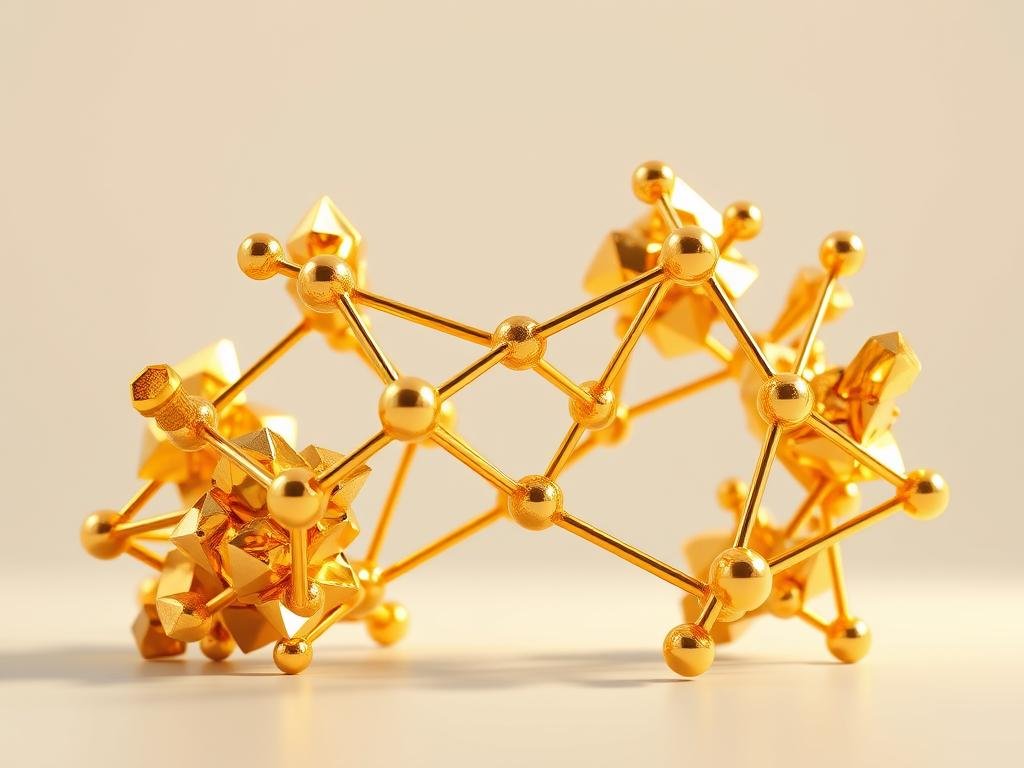Gold is renowned for its distinctive physical properties, one of which is its remarkable densité. This characteristic sets it apart from other metals and contributes to its value and versatility.
The significance of gold’s density is evident in its various applications, from jewelry to investment. Understanding this property is crucial for appreciating its historical value and modern uses.
Among naturally occurring elements, or stands out for its high density. The scientific principles behind measuring density and its relation to gold’s atomic structure will be explored in this article, providing a comprehensive understanding of this precious metal.
The Remarkable Density of Gold
Gold is renowned for its exceptional density, a characteristic that has fascinated humans for centuries. This remarkable property is a key factor in gold’s value and its numerous applications across various industries.
What Makes Gold So Heavy?
Gold’s high density is attributed to its atomic structure and the way its atoms are packed. With a density of 19.32 grams per cubic centimeter, gold is significantly denser than many other materials.
Gold Density in Numbers: 19.32 g/cm³
The density of gold is approximately 19,300 kilograms per cubic meter, or 0.7 pounds per cubic inch. To put this into perspective, a 1-kilogram gold bar is much smaller than a 1-kilogram aluminum bar due to gold’s high density. Gold’s density is also used to verify its authenticity and purity in various industries.
Comparing gold’s density to other materials: water has a density of 1 g/cm³, lead is 11.35 g/cm³, and platinum is 21.45 g/cm³. These comparisons illustrate the unique properties of gold and how its density affects its size and weight relationship.
The Science Behind Gold’s High Density
Understanding the science behind gold’s density requires a dive into its crystalline structure and atomic arrangement. Gold’s high density is primarily attributed to its face-centered cubic (FCC) crystal structure, where atoms are closely packed, minimizing empty space and maximizing mass per unit volume.

Atomic Structure and Mass
The atomic structure of gold plays a crucial role in its density. With an atomic number of 79, gold has a significant mass. The FCC structure allows for efficient packing of gold atoms, contributing to its high density of 19.32 g/cm³. This arrangement enables a high mass per unit volume, making gold one of the densest metals.
“The density of gold is a direct result of its atomic mass and the efficient packing of its atoms,” as noted by materials scientists.
Crystal Structure and Atomic Packing
Gold’s FCC crystal structure achieves approximately 74% space efficiency, minimizing empty space between atoms. This near-optimal packing is described by the atomic packing factor. The coordination number of 12 in gold’s crystal structure relates to its density and malleability. Compared to other metals with different crystal structures, gold’s FCC arrangement leads to a higher density.
The interatomic bonding in gold’s crystal structure also contributes to its characteristic malleability and high density, making it a unique material for various applications.
Measuring and Calculating Gold Density
Gold density measurement is a critical aspect of assessing its purity and quality. To calculate gold’s density, one must divide its mass by its volume. This fundamental principle is applied by measuring the mass in grams or kilograms and the volume in cubic centimeters or cubic meters.
Methods for Determining Gold Density
There are several methods to determine gold density, with one of the most historical and significant being the Archimedes’ Principle. This principle revolutionized the way materials, including gold, were authenticated by providing a straightforward method to calculate density.
The Archimedes’ Principle involves measuring the volume of water displaced by a gold sample, which is equal to the volume of the sample itself. By comparing the weight of the gold in air to its weight when submerged in water, one can calculate its density.
The Archimedes Principle and Water Displacement
The Archimedes’ Principle is based on the concept of water displacement, where the volume of water displaced equals the volume of the object submerged. For gold, this means that if you have a sample of gold with a known mass, you can measure its volume by observing the amount of water it displaces when submerged.
To apply this method, one would follow these steps: measure the mass of the gold sample, submerge it in water, and measure the volume of water displaced. The density is then calculated by dividing the mass by the displaced volume. This method is not only historical but continues to be relevant today in modified forms for gold testing and authentication.
Gold vs. Other Metals: Density Comparison
Comparing gold’s density to that of other metals provides valuable insights into its properties and applications. Gold is one of the densest metals, with a density of 19.3 grams per cubic centimeter.
Precious Metals Comparison
When comparing gold to other precious metals, the density varies significantly. For instance, silver has a density of about 10.5 g/cm³, while platinum has a density of approximately 21.45 g/cm³. Palladium, another precious metal, has a density of around 12.023 g/cm³. These comparisons highlight gold’s unique position among precious metals.

The Gold-Tungsten Relationship
An interesting comparison is between gold and tungsten, which have very similar densities. Tungsten’s density is about 19.2 g/cm³, making it one of the closest metals to gold in terms of density. This similarity has led to tungsten being used in gold counterfeiting. However, various tests, including magnetic and electrical tests, can distinguish between the two metals.
The economic implications of this similarity are significant, particularly in investment markets where verifying the authenticity of gold is crucial.
How Gold Alloys Affect Density
Understanding how gold alloys affect density is key to assessing the purity and value of gold items. Gold is often alloyed with other metals to enhance its durability or change its color. These alloys can significantly alter the density of gold, making it essential to comprehend their composition and effect on density.
Common Gold Alloys and Their Densities
Different gold alloys have distinct densities based on their composition. For instance:
- 18-Carat Gold (75% Gold): The density is typically around 15.6 g/cm³, lower than pure gold due to the presence of other metals.
- 14-Carat Gold (58.3% Gold): This alloy has a density of approximately 12.9 g/cm³, reflecting the higher proportion of base metals.
- 10-Carat Gold (41.7% Gold): With a density of around 10.0 g/cm³, it shows a substantial decrease due to the significant presence of non-gold metals.
Karat System and Density Correlation
The karat system is a measure of gold purity, with 24K representing pure gold (99.9% pure) and a density of 19.32 g/cm³. There’s a direct correlation between the karat rating and density; each decrease in karat represents a proportional decrease in density. This correlation is crucial for quality control and authentication in the jewelry and investment industries. By understanding this relationship, consumers can also use basic density tests to assess the purity of their gold items.
Density measurements can verify the stated karat rating of gold items, providing a standardized way to communicate gold purity. The karat system, also known as millesimal fineness in some countries, is vital for determining the value and authenticity of gold products.
Practical Applications of Gold’s Density
The high density of gold makes it an invaluable material in various industries, from jewelry to aerospace. Its density is a critical factor that contributes to its versatility and value in numerous applications.
Jewelry and Investment
Gold’s density is a significant factor in its appeal for jewelry and investment. The density of gold makes it feel substantial, which is associated with luxury and value. Investors often prefer gold for its ability to maintain value over time, and its high density is a tangible representation of its worth.
Industrial and Scientific Applications
Gold’s high density makes it valuable in specialized industrial applications where weight is needed in minimal space. For example, in the aerospace industry, gold’s density is utilized in balance weights and certain components where space efficiency is critical. Additionally, gold is used in scientific instruments that require precise weights or counterbalances, leveraging its high mass per unit volume. Its density, combined with corrosion resistance and conductivity, also makes gold ideal for electrical contacts in high-reliability applications.
Emerging technologies continue to find new uses for gold’s unique combination of density and other physical properties, further expanding its applications in various fields.
Conclusion
As we’ve explored, gold’s high density is not just a physical property, but a determinant of its utility and worth. With a density of 19.32 g/cm³, or 19,300 kilograms per cubic meter, gold is one of the densest naturally occurring elements.
This characteristic results from its atomic structure and the efficient packing of its atoms, which have a high mass. Gold’s density significantly influences its applications in jewelry, investment, and industry. For instance, understanding gold’s mass-volume relationship is crucial for authenticating and valuing gold products.
When alloyed with metals like copper and silver, gold’s density changes, providing different properties for various applications. Density testing remains a reliable method for assessing gold’s purity and authenticity. The enduring importance of gold’s density lies in its continued value as both a practical material and an investment vehicle.
In modern markets, gold’s density affects its handling, storage, and transportation. For example, a cubic meter of gold weighs 19,300 kilograms, making it a significant consideration for logistical arrangements. Gold’s unique combination of properties, including its high density, ensures its continued importance in human civilization.
